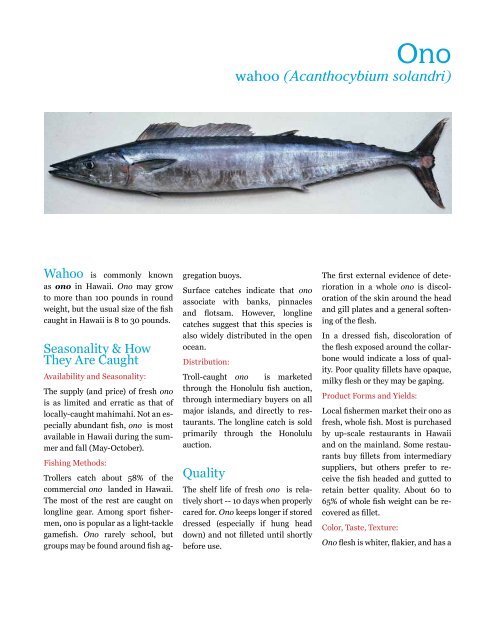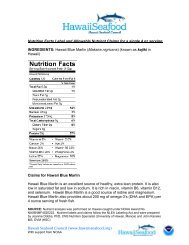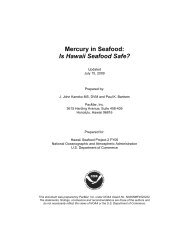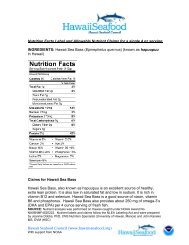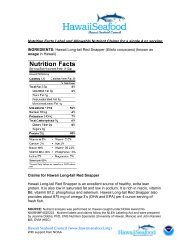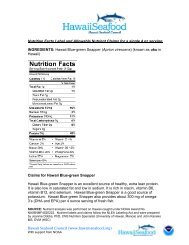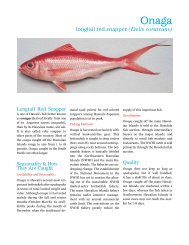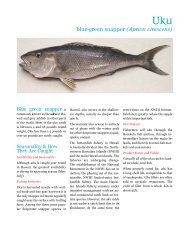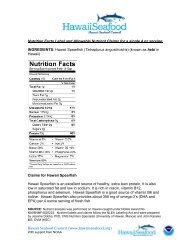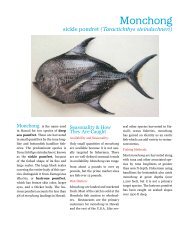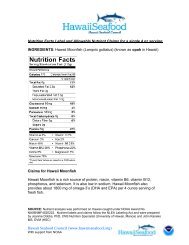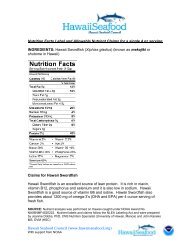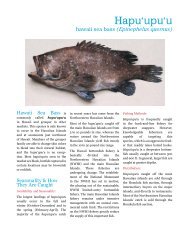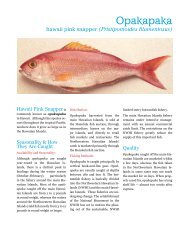wahoo (Acanthocybium solandri) - Hawaii Seafood
wahoo (Acanthocybium solandri) - Hawaii Seafood
wahoo (Acanthocybium solandri) - Hawaii Seafood
You also want an ePaper? Increase the reach of your titles
YUMPU automatically turns print PDFs into web optimized ePapers that Google loves.
Ono<br />
<strong>wahoo</strong> (<strong>Acanthocybium</strong> <strong>solandri</strong>)<br />
Wahoo is commonly known<br />
as ono in <strong>Hawaii</strong>. Ono may grow<br />
to more than 100 pounds in round<br />
weight, but the usual size of the fish<br />
caught in <strong>Hawaii</strong> is 8 to 30 pounds.<br />
Seasonality & How<br />
They Are Caught<br />
Availability and Seasonality:<br />
The supply (and price) of fresh ono<br />
is as limited and erratic as that of<br />
locally-caught mahimahi. Not an especially<br />
abundant fish, ono is most<br />
available in <strong>Hawaii</strong> during the summer<br />
and fall (May-October).<br />
Fishing Methods:<br />
Trollers catch about 58% of the<br />
commercial ono landed in <strong>Hawaii</strong>.<br />
The most of the rest are caught on<br />
longline gear. Among sport fishermen,<br />
ono is popular as a light-tackle<br />
gamefish. Ono rarely school, but<br />
groups may be found around fish aggregation<br />
buoys.<br />
Surface catches indicate that ono<br />
associate with banks, pinnacles<br />
and flotsam. However, longline<br />
catches suggest that this species is<br />
also widely distributed in the open<br />
ocean.<br />
Distribution:<br />
Troll-caught ono is marketed<br />
through the Honolulu fish auction,<br />
through intermediary buyers on all<br />
major islands, and directly to restaurants.<br />
The longline catch is sold<br />
primarily through the Honolulu<br />
auction.<br />
Quality<br />
The shelf life of fresh ono is relatively<br />
short -- 10 days when properly<br />
cared for. Ono keeps longer if stored<br />
dressed (especially if hung head<br />
down) and not filleted until shortly<br />
before use.<br />
The first external evidence of deterioration<br />
in a whole ono is discoloration<br />
of the skin around the head<br />
and gill plates and a general softening<br />
of the flesh.<br />
In a dressed fish, discoloration of<br />
the flesh exposed around the collarbone<br />
would indicate a loss of quality.<br />
Poor quality fillets have opaque,<br />
milky flesh or they may be gaping.<br />
Product Forms and Yields:<br />
Local fishermen market their ono as<br />
fresh, whole fish. Most is purchased<br />
by up-scale restaurants in <strong>Hawaii</strong><br />
and on the mainland. Some restaurants<br />
buy fillets from intermediary<br />
suppliers, but others prefer to receive<br />
the fish headed and gutted to<br />
retain better quality. About 60 to<br />
65% of whole fish weight can be recovered<br />
as fillet.<br />
Color, Taste, Texture:<br />
Ono flesh is whiter, flakier, and has a
more delicate texture than the meat<br />
of other fast-swimming, pelagic<br />
species. Although ono may make<br />
oceanic migrations as far as those<br />
of tuna and marlin, it contains less<br />
of the strong-tasting “blood meat”<br />
muscle that the latter species use for<br />
long-distance swimming.<br />
Preparations<br />
Although ono is versatile in its uses,<br />
cooking methods suitable for “lean”<br />
not dry out when cooked. One way<br />
poach.<br />
Historical Note<br />
Ono is a <strong>Hawaii</strong>an word meaning<br />
“good to eat.” The ono was said by<br />
the ancient <strong>Hawaii</strong>ans to be the parent<br />
of the opelu, a mackerel scad of<br />
great importance to the subsistence<br />
of the early <strong>Hawaii</strong>ans.<br />
mapped the <strong>Hawaii</strong>an Islands found<br />
ono to be plentiful off the island of<br />
Oahu. Maps of the time indicate that<br />
a very common spelling of the word<br />
“Oahu” was “Wahoo,” and this is beother<br />
name.<br />
<strong>Hawaii</strong> <strong>Seafood</strong> Council<br />
Acknowledgement: produced with support from NOAA<br />
www.hawaii-seafood.org


